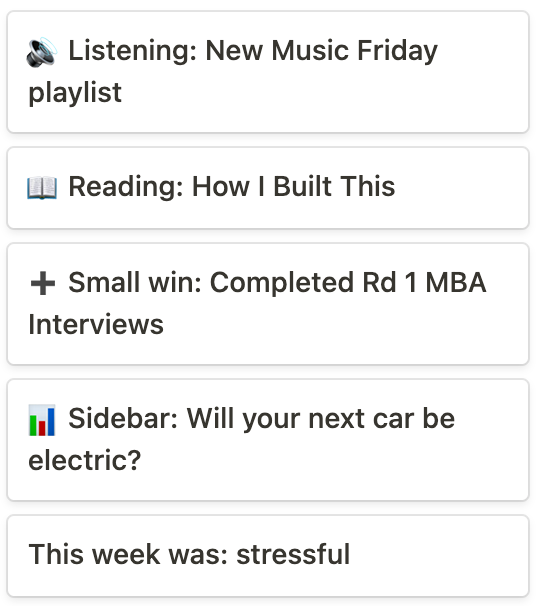Circle Three: the eleventh
Twins. Trees. 2020's Things.
Welcome to Circle Three!
Electric automobiles and solar panels continue to take the stage in mass media and the financial markets. Those in America might see an electric vehicle here and there (unlike Norway where more than half of the vehicles sold in 2020 were electric). But we are far from mass adoption of renewable energy in our daily lives.
This new year promises lots of change. I, and many others, hope for it. Do you think you will adopt or continue to use a source of renewable energy in your daily life this year? What will be your first adoption either this year or in the future? See another question in the State of the Circle.
This week find a Big Idea from Martin Luther King, links about the things of 2020, trees, and singing, and writing about Digital Twins. Enjoy the eleventh issue!
Cheers,
Dan
So what’s Circle Three? For new readers, the name comes from Seth Godin’s Linchpin, where he posits that the internet has created a circle beyond family and business: a tribe. Where knowledge is exchanged and our gifts are shared.
Thanks for being a part of this third circle. Let’s create something.
One Big Idea
“Our lives begin to end the day we become silent about things that matter.” -Martin Luther King
Following MLK day last month, this quote hits at the importance of speaking your truth. “Things that matter” are different for each person, and it’s our duty to bring attention to those things that matter to us and to society at large. What things do you speak up about?
Circles of Thought
The Year in Things: Vox’s look at 2020 through the things that made it special. Bread, Peloton, toilet paper, masks, and more.
Watch this short, well-animated video on the complicated effort to restore depleted ecosystems through one trillion trees.
What3Words is a map system that divides the globe into 3-meter squares and assigns each square a unique three-word combination. Great for concerts, festivals, tailgates, and anywhere else you need to share a precise location.
Here’s a post from Wes Kao on how to set yourself up for success when starting a new job or joining a new team. Take an active stance or note areas of opportunity to make immediate contributions.
Here’s a fun combination: de-stresser and chord experimentation. Sing away with this hilariously fun mouth.
Inner Circle: Digital Twins
How virtual replicas of physical systems are changing how we live and work.
Twins. We all know a twin (or two). They might share similar mannerisms or be identical; they might even have twin telepathy.
Digital twins have similar characteristics.
In its’ simplest form, a digital twin is a virtual replica to describe a physical product. They have exploded in popularity and are changing business operations in sectors like manufacturing, automotive, and healthcare. I will not dig into the technical representations of digital twins, but the growing popularity and applicability of digital twins across business sectors make a base understanding important for everyone. At the very least, I want to introduce the concept.
The digital twin is a dynamic virtual representation of an object or system to mirror the life of the physical counterpart and allow for real-time optimization. Real-world examples of these include 3D modeling techniques, power turbines, and utility systems.
The twin in all three examples is a digital companion for the physical system or object. Sensors collect real-world data to to create an up-to-date digital twin, enabling learning and reasoning before making the physical product. Digital twins can reduce product defects for objects that have yet to be manufactured and save resources.
With the developments of artificial intelligence and increasingly precise technology, sensors and data will continue to manipulate and optimize digital twins. In recent years, digital twins have advanced beyond simple physical assets like the examples above and moved into entire systems — “connecting not just one asset, but rather systems of assets or even entire organizations.”
Digital twins can be used to optimize buildings, organizations, and even people as we move towards more and more integration between technology and our daily lives. The watches we wear and phones we carry provide constant flows of data and act as the go-betweens, like the sensors connecting a digital twin and a turbine. Developments in healthcare can create our own personal digital twins to improve care and costs; the use of AI can optimize internal organizational interactions and structure.
This is a shallow dive into digital twin technology and what the future may bring, but reveals enormous opportunities in the space during the upcoming years and decades. As we move towards the Internet of Things, AI, and optimization analytics, digital twins will become a more quotidian element of our lives.
State of the Circle
If you like what you’re reading and want to share it, click below!



